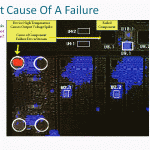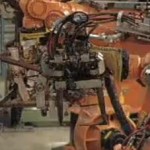What is Predictive Maintenance
Predictive maintenance uses a number of tools and techniques to monitor the condition of your machines and equipment to predict when problems are going to occur by identifying the symptoms of wear and other failures. Also known as reliability centered maintenance and condition base maintenance it seeks to make our maintenance more economically efficient by allowing us to use components within the machines that would be replaced at regular intervals under preventative maintenance programs for far longer, sometimes several times their expected life spans.
It also allows us to see if components that may not be covered by simple preventive maintenance are beginning to show signs or wear and failure.
Why do we need predictive maintenance
We need a maintenance program for our company to prevent the occurrence of breakdowns which lead to unplanned downtime of our machinery which in turn can cause us to fail to meet customer demands. Unreliable machinery also drives us to hold excessive inventory through overproduction (see the seven wastes of lean manufacturing) to try to cushion us against the effects of any breakdowns.
A predictive maintenance program can aid us to make our machines more reliable and predictable by monitoring their performance allowing us to see when problems are beginning to start and make repairs and replacements before actual breakdowns occur or cause other more expensive problems.
Predictive Maintenance tools
There are a number of predictive maintenance tools and techniques that can be employed either by your own maintenance technicians or through the employment of a specialized third party who can come in on a regular basis to do monitoring. The beauty of most of the predictive maintenance techniques is that they require machines to be running at normal capacity and do not interfere with your production schedules.
Below are some of the more common predictive maintenance tools;
Thermal Imaging
Most people are familiar with the idea of thermal imaging using infrared; this technique allows you to use infrared thermal imaging to take a thermal image of your equipment to identify any hotspots. Worn components and malfunctioning electrical circuits will generate heat that will show up on the thermal image as a hot spot enabling you to pinpoint any potential problems, often before they lead to a breakdown or cause significant damage.
Vibration Analysis
By using either a hand held vibration analyzer or using monitors built into the machinery you can monitor the vibrations of a machine. As things such as shafts and bearings begin to wear and fail they will generate different vibration patterns which can be recognized by trained individuals. Vibration analysis can be very accurate and can quickly identify problems, comparing the readings against known failure modes can pinpoint exactly where problems are occurring.
Sonic and ultrasonic analysis
This works in much the same way as vibration analysis, with the machines vibrations creating sounds (often outside of the range of our hearing) that can be monitored to allow us to “see” problems as they start to appear.
We can also use ultrasonic analysis to find cracks and poor welds in structures before they become visible of cause a significant problem
Oil Analysis
Oil Analysis is conducted to check the condition of the oil itself and see what other particles and liquids are present. It can quickly highlight leaks of other fluids such as coolant even if very small and the particles of metal components can be measured and identified to show what parts of the machine are wearing and by how much.
Emission Testing
Emission testing of waste gases and effluent is not just for environmental purposes, the composition of gases and what is present in your effluent can tell you a lot about the current state of your machinery and identify problems as the start rather than have them become full scale breakdowns. Many companies have to have processes in place for these purposes and can benefit from this additional check on their processes
Condition Monitoring
You can fit sensors directly to the machines to measure the above items as well as monitoring the various process variables such as load on motors and so on. All of these can be automatically measured and monitored either through a central system or even remotely by an outside company responsible for monitoring your equipment.
Alternatives to Predictive Maintenance
There is obviously a cost to using predictive maintenance techniques, in most cases these costs are vastly outweighed by the benefits you will gain with the extended use of components and the prevention of breakdowns. However if you only have a few machines you may find that “normal” preventive maintenance where you service the machines at predefined intervals may be more economical. Preventative maintenance (just like servicing your car to keep it in good condition and prevent breakdowns) can be an economical method of maintaining your machines in many circumstances. However predictive maintenance can still make savings as it will often identify problems that would never be picked up by routine inspections.
Predictive Maintenance and Total productive maintenance
Preventive and predictive maintenance are very important considerations for any lean manufacturing and total productive maintenance (TPM) program. You cannot improve your processes if your machines and equipment are unreliable and working inefficiently.
Combined with autonomous maintenance they can help to split the load and responsibilities for maintenance and the monitoring of the machines with the operators also. This allows the maintenance technicians to become more involved in preventing problems and the operators to become more aware of their machines and how they should run.
TPM tackles the six big losses of machinery not just the problem of breakdowns;
- Breakdowns
- Setup and Adjustment losses
- Idling and minor stoppages
- Reduced Speed
- Defects and rework
- Start-up losses
These losses are monitored through a measure known as OEE or overall equipment effectiveness, focusing on this measure and its individual components makes us consider more than just the problems associated with breakdowns. We have to tackle quality problems with tools such as Poka Yoke and improve the speed and effectiveness of our setups with lean manufacturing tools such as SMED or Single Minute Exchange of Die.
Predictive Maintenance Video
Predictive maintenance is very much a part of any TPM implementation, if you have any questions regarding predictive maintenance or TPM please leave them below.



Can i have any demo for predictive maintenance, wtih real example.
like Compressors, Skid, SDV or other plant equipment’s.
Dear sir
This is manoj prajapati i am working in mainteace department but my predictive and preventie maintenance knowledge not good i dont explain about it to any one when anyone ask about this so plss if you have such type any knowledge then plss email me thank you
i liked the explanation about predictive maintenance